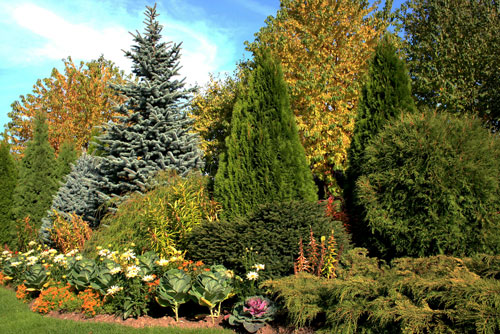
Bio Green Micromend 0-0-2 Fertilizer
January 31, 2022
When is the Best Time to Plant Grass in Ohio
June 5, 2023Bagworms in Ohio: A Trees & Landscapes Threat
What Are Bagworms?
Bagworms (Thyridopteryx ephemeraeformis) are destructive pests that pose a significant threat to trees and landscapes in Ohio. These caterpillars belong to the family Psychidae and are known for constructing distinctive spindle-shaped bags made of silk and camouflaged with bits of plant material. This essay will delve into the background of bagworms, their impact on Ohio's trees and landscapes, and the strategies employed to manage their infestations.
Background on Bagworms
Bagworms go through a complete metamorphosis, starting as eggs laid within their mother's bag. The eggs hatch in late spring or early summer, and the larvae emerge to begin feeding on the foliage of host plants. As they grow, the larvae construct their protective bags, which they continuously expand and carry with them as they feed and move. The bags provide camouflage and protection from predators.
Bagworms are polyphagous, meaning they feed on a wide range of trees and shrubs. In Ohio, common host plants include evergreens like arborvitae (Thuja spp.), spruce (Picea spp.), and juniper (Juniperus spp.), as well as deciduous trees such as maple (Acer spp.), oak (Quercus spp.), and willow (Salix spp.). These pests can cause significant damage to their host plants, leading to defoliation, branch dieback, and even death if left uncontrolled.
Bagworm Infestations in Ohio
-
Devastation of Trees and Landscapes Bagworm infestations have been reported throughout Ohio, affecting both urban and rural areas. The caterpillars feed voraciously on the foliage of host plants, defoliating entire branches and weakening the overall health of the tree. Severe infestations can lead to significant tree decline and mortality, impacting the aesthetic value of landscapes and the ecological functions provided by trees.
-
Economic Consequences The economic consequences of bagworm infestations are multifaceted. For homeowners, infestations can result in the loss of valuable trees and negatively affect property values. Landscapers and arborists may face increased costs for bagworm control and tree maintenance. Additionally, municipalities and local governments may incur expenses for the removal and replacement of severely infested trees in public spaces.
-
Environmental Impact Bagworm infestations can disrupt the natural balance of ecosystems in Ohio. Trees provide critical habitat for various wildlife species, and the loss of trees due to bagworm damage can reduce biodiversity and alter ecosystem dynamics. Furthermore, the weakening of trees by bagworms makes them more susceptible to other pests and diseases, exacerbating the overall stress on Ohio's forested areas.
Management Strategies for Bagworms
-
Biological Control Biological control methods can help manage bagworm populations in Ohio. Natural enemies, such as parasitic wasps and predatory insects, can play a crucial role in controlling bagworm infestations. These natural predators help keep the pest population in check by attacking eggs, larvae, or pupae. Encouraging and preserving the presence of these beneficial insects in landscapes can help reduce the need for chemical intervention.
-
Chemical Control In cases of severe infestations or when other management methods are not effective, chemical control measures may be necessary. In Ohio, insecticides containing Bacillus thuringiensis var. kurstaki (Btk) are commonly used to target bagworm larvae. Btk is a naturally occurring bacterium that specifically targets caterpillars while being safe for other beneficial insects, birds, and mammals. Proper timing and application techniques are crucial for effective chemical control.
-
Cultural Practices Cultural practices can aid in managing and preventing bagworm infestations. Regular inspection and early detection of bags on trees can help identify and address infestations before they become widespread. Handpicking and destroying bags during the winter months when the larvae are dormant can also help reduce populations. Pruning and maintaining tree health through proper watering, fertilization, and mulching can improve tree resilience and reduce susceptibility to bagworm damage.
Proactive Measures for Bagworm Control
Bagworms pose a significant threat to Ohio's trees and landscapes, causing defoliation, tree decline, and economic losses. However, through a combination of biological control, targeted chemical interventions, and cultural practices, it is possible to manage bagworm infestations and mitigate their impact. Educating homeowners, landscapers, and arborists about bagworm identification, monitoring, and management strategies is crucial for effective control. By taking proactive measures, Ohio can preserve its tree canopy, protect its landscapes, and maintain the ecological balance of its natural areas.
Sources:
- Ohio State University Extension. (n.d.). Bagworm. Retrieved from https://ohioline.osu.edu/factsheet/HYG-2145
- Johnson, W. T., & Lyon, H. H. (2021). Insects That Feed on Trees and Shrubs. Cornell University Press.
- Pennsylvania State University Extension. (n.d.). Bagworm. Retrieved from https://extension.psu.edu/bagworm
- Texas A&M AgriLife Extension. (n.d.). Bagworms. Retrieved from https://agrilifeextension.tamu.edu/library/landscaping/bagworms/
- University of Kentucky Entomology. (n.d.). Bagworm. Retrieved from https://entomology.ca.uky.edu/ef451
Do you have an issue with bagworms? Schedule a free consultation and let's talk about your bagworm treatment program!


